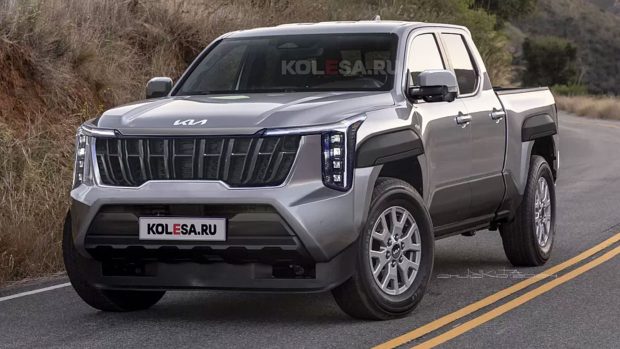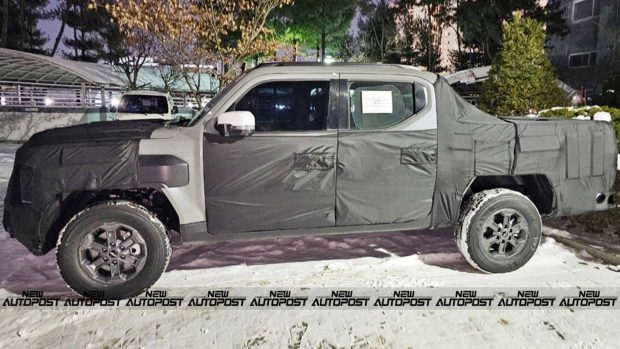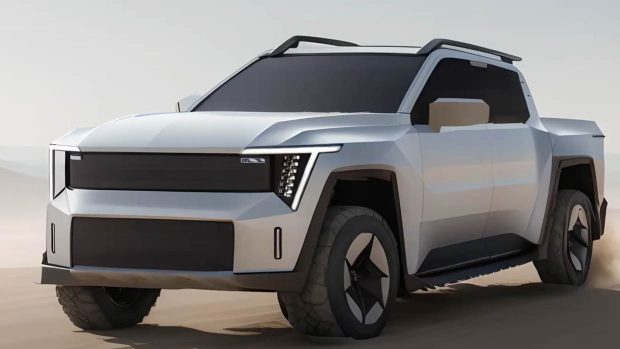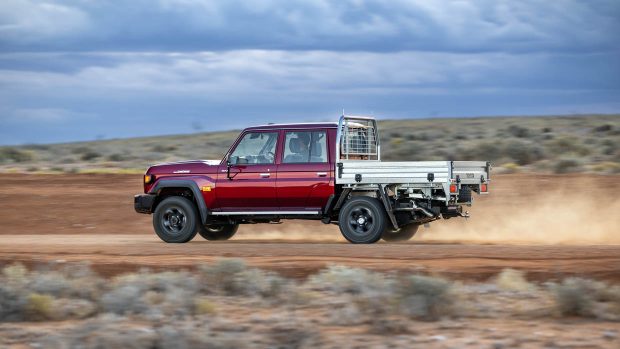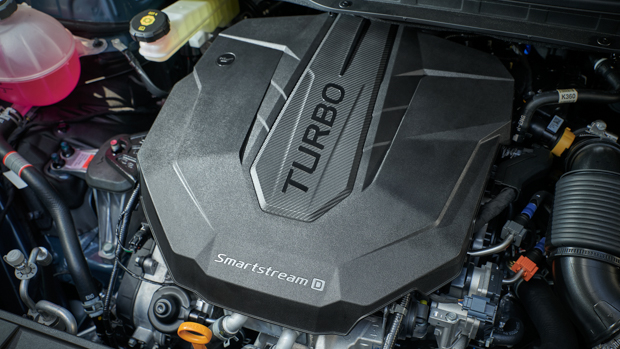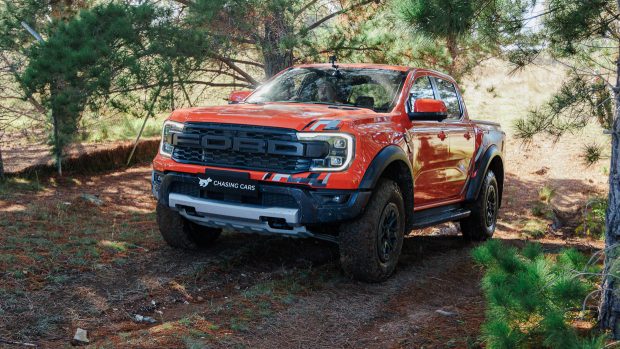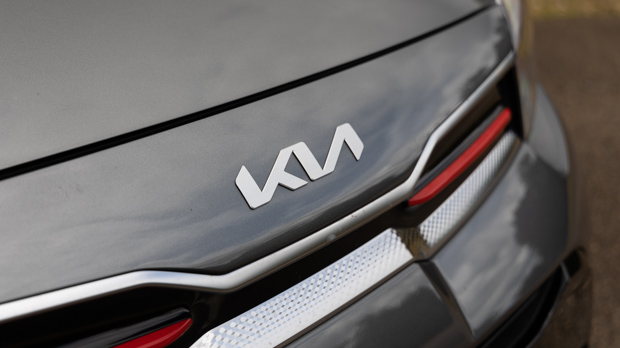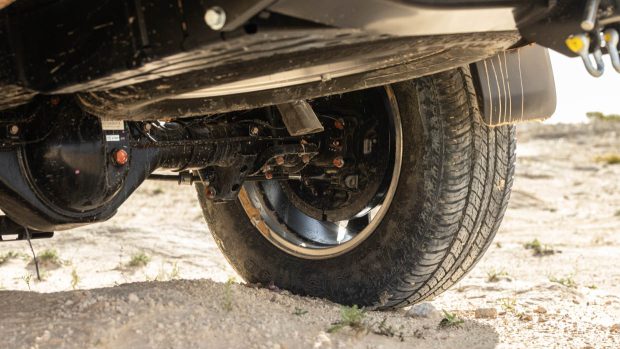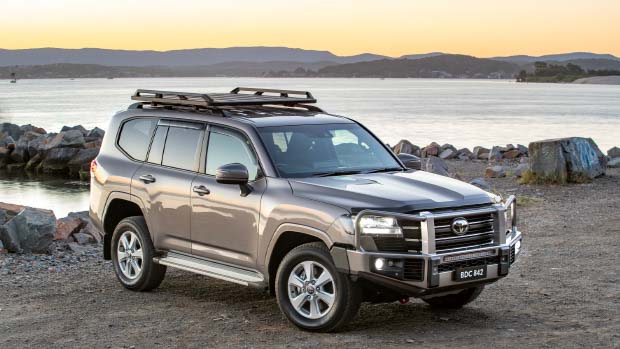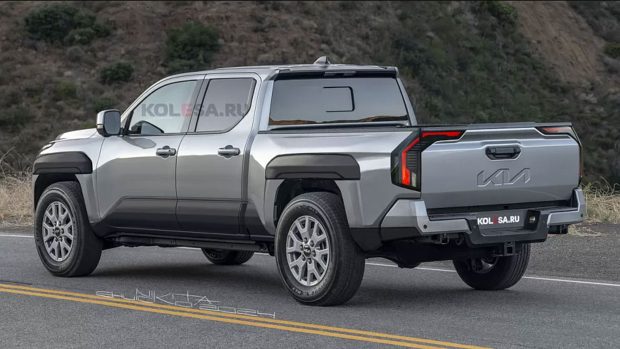-
Car Reviews
- All reviews
- Midsize SUVs
- Small cars
- Utes
- Small SUVs
- Large SUVs
- Large cars
- Sports SUVs
- Sports cars
- Vans
Latest reviews
- Car News
-
Car Comparisons
Latest comparisons
- Chasing Deals
It’s the ute that’s expected to shake up the segment, with new details revealing just how much of a threat Kia’s ute could be to its established rivals
With Australian ute sales booming, Kia is preparing to introduce its own contender in just over a year’s time with the soon-to-be-announced Tasman – a separate-chassis, single- and dual-cab ute aimed directly at the huge-selling Ford Ranger and Toyota Hilux.
Designed and manufactured in Korea but currently undergoing development testing around the world, the Tasman will launch in Australia before the end of the financial year in 2025, offering the broadest-possible range covering everything from cab-chassis commercial variants to range-topping lifestyle models competing with the highly profitable Ranger Wildtrak/Platinum and Hilux SR5/Rogue.
We’re already referring to Kia’s ute as the Tasman, though the nameplate’s official confirmation won’t happen until March. Kia’s legal and brand teams in Korea only registered one name in the lead up to this announcement – not multiple alternatives to confuse inquisitive motoring journalists – making ‘Tasman’ arguably the industry’s worst-kept secret.
Incidentally, the name was put forward by Kia Australia’s product-planning team and immediately received a strong reception in head office.
Up to 100 camouflaged Kia Tasman prototypes will be distributed to global R&D centres to complete development testing – several are already in Sweden undergoing cold-weather analysis – with two prototypes arriving in Australia in late April or early May.
This marks the first time that Kia Australia has been directly involved so early in a vehicle’s product development, underlining the importance of the Tasman ute for our market.
Product information will be progressively rolled out by Kia in the lead up to the Tasman’s early 2025 global unveiling, but here’s everything we know so far:
Speaking exclusively to Chasing Cars, Kia Australia’s general manager for product planning, Roland Rivero, said the aim with the Tasman is to deliver a vehicle that can comprehensively compete with its best pickup rivals.
Intended to be sold in Australasia, Africa, Asia and the Middle East (but not Western Europe or the US), the Tasman “will be very much a workhorse tool-of-the-trade as it will be for the lifestyle market,” said Mr Rivero.
It’s being closely benchmarked against the latest Ford Ranger – a vehicle whose engineering development was done in Australia – to cover “every little component,” said Mr Rivero. “Even down to how comfortable are the seats, how’s the padding? What’s the legroom like? What’s the welding shaft on the chassis rails? It’s every little nuance of the [Ranger] product.”
Hardware-wise, expect the Tasman ute to remain fairly conservative in order to achieve Kia’s desired level of robustness. “Considering what this type of product is utilised for [when] put through its paces, durability and reliability are very, very important trademarks, very important traits that the ute is going to have,” he said.
As for what will set the Kia Tasman apart from its vast competitor set, Mr Rivero was highly positive about several key areas.
“It will look a little bit unique in the marketplace – it’s challenging the status quo in that regard,” he said, much like several recent Kia designs such as the EV9 large SUV. “And it also has probably one of the best second rows for space and comfort. It will [likely] be class leading.
“The tray is going to be quite big – probably among the best in the category. And it will have the ability to fit a Euro palette [like Ranger, Amarok and new Triton].
“We had some non-negotiables that we were adamant about during the development process with R&D. One of those is a five-star ANCAP rating. Another is 3.5-tonne towing capacity. And the other is greater than a tonne payload.
“Those non-negotiables have to carry through to ensure the success of this product. And, interestingly, some of those are some of the things that our fleet customers have been telling us as well.”
“If you dissect [the ute category], the biggest contributor to sales is four-cylinder diesel, available in 4×4 and 4×2. And in bodystyles, the dual-cab is the key volume [though] we’re still mindful that there’s plenty of single-cab [volume] out there – in cab-chassis, not so much pick-up.
“We’ve looked at all the bodystyles – looked at the biggest-volume areas and components. And we’ll be targeting the bigger-volume areas.
“Don’t expect an extra-cab or a one-and-a-half cab – as we’ve observed, it’s diminishing and declining in terms of its mix. But single and double, in cab-chassis and pick-up, is definitely on the cards.
With such a focused benchmarking process on every aspect of the Ford Ranger (and related Volkswagen Amarok), it’s impossible for Kia to ignore the breadth of powertrain choices available in those vehicles … and even the wealth of potentially suitable drivetrains among the broader Hyundai-Kia stable.
“We’re very much aware of the number of powertrains on offer from the two major benchmarks … and it’s not easy to replicate,” said Mr Rivero.
“This is our first attempt at a pick-up, and more than likely as we go through the process – and given that all light-commercial vehicles do have an extensive model life – there will be plenty of opportunities to enhance and increase our [drivetrain] offerings.”
In other words, expect to see a roll-out of various drivetrains over time, rather than everything being available at launch.
A development of Hyundai-Kia’s 148kW/440Nm 2.2-litre four-cylinder ‘R-series’ turbo-diesel will form the backbone of the Tasman line-up – tied to an eight-speed torque-converter automatic (as per the Carnival diesel) rather than the Hyundai N-derived eight-speed dual-clutch used in the Sorento and Santa Fe/Palisade diesel SUVs.
As for a manual transmission, “globally, it’s on the cards because a manual is still favoured in parts of Asia and other markets and regions. We’ve just got to work around the ANCAP component, because we have always said it’s got to be five stars, and some of the advanced active-safety features don’t work so well with a manual transmission.
There might be creative ways around it but at this point in time, [Tasman] is automatic only,” said Mr Rivero.
With Australia and South Africa featuring so prominently in global Tasman volume, this will be one Kia where powertrain choice won’t be limited in right-hand-drive versions. But whether Kia can access its vast array of engine types for the Tasman remains to be seen.
“Every permutation and combination has to be looked at and interrogated to ensure that there is a business case for it. The numbers have to stack up. For example, if any particular powertrain was less than five percent of the mix, it really wouldn’t get a look in. And it has to be a powertrain that would also appeal globally.
“As much as possible, we are steering the product to be as Australianised as possible. And we’re confident that at least we are hitting the big-ticket areas. But if there were, say, niche pockets of powertrains that exist, we’ve got to make sure that there’s a good enough business case.”
Including the powertrain appetite of the Middle East seemingly opens the door for a potential twin-turbo petrol V6 in the Tasman (as per Ranger Raptor) – shared with various Genesis models and the now-discontinued Kia Stinger.
“The Middle East would [be interested in that powertrain]. But as you can understand, it’s a little difficult for us with the looming NVES (New Vehicle Efficiency Standard) that’s potentially coming. But [the twin-turbo V6] does exist. It’s something that could be utilised. But time will tell,” said Mr Rivero.
The benefit of starting with a clean slate and an all-new platform gives the Tasman a distinct advantage over its older competitors when incorporating forms of electrification.
“We’ve talked about the global plan of Strategy S, which stands for ‘shift’ – that shift towards cleaner electrification, and that’s definitely something that we are studying as something that could be part of the key ute range in the future, but not from the get-go,” said Mr Rivero.
“Every product moving forward for the Kia family is always thinking of ways to be electrified in some way, shape, or form.
“It’s definitely on the cards [for Tasman],” he said.
Expect the Tasman to closely follow the tried-and-tested blueprint for this type of vehicle, meaning separate-chassis construction with independent front suspension and a live rear axle with leaf springs.
“I think the traditional [set-up] works quite well from a towing and a down-ball [load] perspective, so we’re very much in line with the marketplace in that regard,” said Mr Rivero.
As for whether the Tasman’s Australian suspension tune will be deployed in other markets, “I can’t speak on behalf of what Middle East, the domestic market, Africa and other regions will nominate,” said Mr Rivero. “The domestic market will probably have a different one to us – they do prefer a different dynamic behavior to Australia.
“What matters most to us is that we’re able to develop a ride and handling tune and spec for Australia that we think is what resonates for the Australian market.”
“The [Tasman] prototypes will be predominantly [for] developing accessories and we’ve already done some accessory fitments in Korea with canopies and alloy trays, steel trays. We had to send our suppliers over there to do some fitments and that is an ongoing thing.
“South Africa has got similar needs to us, and they’re big on bull bars as well [which we’re developing]. The department of primary industry has told us that ‘we’ve got a policy – it has to have a bull bar’ for all their reps on the road. Sydney Water is the same – any time you’re in the bush in rural Australia, you must have a bull bar,” said Mr Rivero.
“We’re definitely looking at downgrading it, that’s for sure, but it’ll still be seven years,” said Mr Rivero.
In terms of distance coverage for Kia Australia’s first commercial vehicle since the Pregio van of 2006, “it’s probably something that we need to study a little bit further – it’s to be confirmed [whether it remains unlimited kilometres]. For fleets and ABNs, it’s something that we will have to look at,” he said.
“[But] it’s something that we’ll look at as a way to really kickstart [Tasman sales] and have a good, fast start. So at this stage, watch this space.”
“There is very much a substantial market there that is still quite buoyant in Australia, and we wouldn’t be going through this journey if we thought that we were coming in too late, that we couldn’t capitalise and make the most of it [with Tasman].
“So we’re fairly confident that the ute [category] will continue to be an important part of the Australian landscape for many more years to come.
“We’re in it. We’re in for the long run as well. We’re investing in it, and we think that it still has a huge opportunity. We don’t believe we’re too late – I mean, it would’ve been great to have launched a bit earlier. But even if we launch in the middle of March 2025, it presents a huge incremental opportunity for Kia.
“Because we are a latecomer to what is almost a heritage category … we’re not gonna be complacent about it and we’ll do our best to ensure no stone is left unturned [in making the Tasman product as good as it can possibly be],” said Mr Rivero.
With potential sales volumes in the tens of thousands, the Tasman will be Kia Australia’s most important new model entrant in many years – opening up the possibility for the brand to achieve in excess of 100,000 annual Australian sales, and a potential number two manufacturer position … if the Tasman strikes a chord with Aussie ute buyers.
Latest news
About Chasing cars
Chasing Cars reviews are 100% independent.
Because we are powered by Budget Direct Insurance, we don’t receive advertising or sales revenue from car manufacturers.
We’re truly independent – giving you Australia’s best car reviews.
